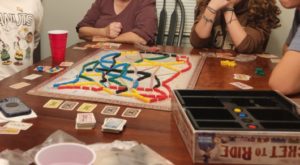
How to Make a Sincere Apology
 by Jessica Frierson, April 2023
by Jessica Frierson, April 2023
One of the things that really bothers me as a parent is hearing my children mutter an insincere “I’m sorry.” In search of a way to make the phrase more meaningful, I considered what the point of an apology is to begin with. It is often blurted out for no purpose other than to assuage the anger of an offended party. In its best form, the intent of an apology is to make reconciliation with someone whom we have wronged with an accompanying endeavor not to repeat the offense.
With that in mind, I set out to train my children to think more carefully before saying two quick words that held little meaning. I want them to develop the habit of taking time to consider how their words and actions affect others. They need to understand that there is a moral standard set by God by which we must live. Furthermore, true repentance of a wrong means that we intend to change our ways – and that requires a plan. Finally, we can ask for forgiveness, but we can not demand it.
A four-step apology is the result of my ponderings. Initially, I implemented this by walking my children through each step several times a week as they had little squabbles and quarrels with each other. After some time had passed, they only needed a gentle nudge to remind them to pause and think it through before responding to a sibling’s cries or complaints with a sincere apology. They no longer go through each step every single time, because they have now developed a greater awareness of the importance of being sincere. If I sense they have slipped back into complacency, we will focus again on these steps.
1. I’m sorry for…
It is important to clearly state what one is apologizing for. The offended or hurt person needs to hear it as much as the one who committed the “crime.”
2. It was wrong because…
Can we be truly sorry for something if we don’t know why it is wrong? It may be wrong because God’s word clearly says it is (such as stealing or hurting someone in anger), it may be wrong because of our motives (intentionally aggravating the other person or attempting to make them look bad, for example), and it may even be unintentional.
3. In the future I will…
What could be a better time to learn how to avoid making the same mistake twice than when one is in the middle of that moment of remorse for making it the first time? I teach my children to think about what caused them to do what they did and figure out what would have been a better response. If they hit their sister because they were angry that she had taken their toy, a better response would have been to walk away until they calmed down, then ask her to return it, and finally to seek a parent’s assistance. Or if they ruined their brother’s new shirt by knocking over his grape juice while hastily reaching for the syrup, they can see that patience and using better manners to ask for items to be passed to them can prevent spills.
4. Will you forgive me?
Forgiveness is a gift that is asked from others. They may choose not to offer it, or they may need some time until they are ready to give it. This final step of the apology may be left open-ended. I noticed that this tends to be as rushed past as the insincere “I’m sorry” is. I want my children to understand the importance of both seeking and granting forgiveness.
So here is what it looks like in action. Let’s say that Michael took his brother Timothy’s football outside to throw around. Timothy is upset that Michael has his new football. Michael’s apology would sound something like this. “I’m sorry for taking your football without your permission. I just wanted to play with it, and you wouldn’t let me. It was wrong for me to do that because I was not respecting you and because the tenth commandment says that I should not covet what belongs to someone else. In the future, I will not touch your belongings without your permission. Will you forgive me?
I can tell you from my experience raising ten children that an apology like this goes far in smoothing over angry feelings between siblings. Prior to this, I heard many responses of, “No you aren’t!” to the quick apologies, or they were just outright ignored. By taking the time to reflect on what wrongdoing was committed, why it was wrong, and how to avoid it in the future, topped off by a request for forgiveness, anger has time to dissipate, and the door is opened for a peaceful resolution.
 Jessica Frierson is a second-generation homeschooler. She is married to Ernie, a retired minister. They have been homeschooling their seven sons and three daughters since 2000. She is a speaker and writer. She serves as the secretary for NCHE, writes for GREENHOUSE, and is the lead blogger for the NCHE blog.
Jessica Frierson is a second-generation homeschooler. She is married to Ernie, a retired minister. They have been homeschooling their seven sons and three daughters since 2000. She is a speaker and writer. She serves as the secretary for NCHE, writes for GREENHOUSE, and is the lead blogger for the NCHE blog.
I am sorry photo by Brett Jordan on Unsplash, angry girls photo by Obie Fernandez on Unsplash, forgive me photo by mark tulin on Unsplash
The Value of Being There
by Diane Helfrich, April 2023
 There are multiple ways to take in a football game. For example, you can listen on the radio (probably in your car because the only person I know who still does that at home is my husband—he likes the radio announcer for the Denver Broncos). Maybe you like to watch it by yourself at home. Then, there is the option of having friends join you to share food and fun during the game. Last and certainly not least is attending the game in person. Each of these ways gives you a different experience. The same is true of a concert, a play, or a parade. So, I have a question for you. Which one stirs the most energy within you? The answer is pretty obvious.
There are multiple ways to take in a football game. For example, you can listen on the radio (probably in your car because the only person I know who still does that at home is my husband—he likes the radio announcer for the Denver Broncos). Maybe you like to watch it by yourself at home. Then, there is the option of having friends join you to share food and fun during the game. Last and certainly not least is attending the game in person. Each of these ways gives you a different experience. The same is true of a concert, a play, or a parade. So, I have a question for you. Which one stirs the most energy within you? The answer is pretty obvious.
When you attend a game or event in person, you are part of engaging in a large event with excitement all around you. The excitement seeps into you and creates deep-seated memories that last a lifetime. In contrast, when you watch it alone, you turn off the TV in silence, head to bed, and remember the score and a play or two in the morning.
The Thrive! Conference is like that. You can read about it later, talk to friends who went, listen to talks on MP3s, or take in nothing at all. Should you choose that last option, you miss out on tremendous things! If you can’t attend in person, I recommend listing to MP3s because the talks are excellent. Better yet, come and experience it in person!
nothing at all. Should you choose that last option, you miss out on tremendous things! If you can’t attend in person, I recommend listing to MP3s because the talks are excellent. Better yet, come and experience it in person!
When you attend the Thrive! Conference in person, just like that football game, there is a kind of energy and excitement that seeps into your soul and feeds you for the coming year. Like-minded people surround you on a similar journey. Everyone around you is being energized by the information they are taking in. Happiness and conversation reigns everywhere. There are many kids who are all excited to be there. Fear is subsiding, confidence is building, and the energy in the building is palpable—you can feel it when you walk in! Finally, you learn not only things about teaching your kids but about family and marriage dynamics.
Here is a sampling of some of the topics for this year:
- Ten Messages I Would Tell My Younger Homeschooling Self
- Turning High School Experiences into Transcripts That Are Impactful
- 10 Ways to Stop Defiance, Meltdowns & Disrespect
- The Three Best Things I Did as a Homeschool Dad
- The World of Worldviews Marriage, Communication and Friendship
- Laying Down the Rails: The Power of Good Habits in Your Homeschool
- Money Matters: Saving and Paying for College
- Lifeschooling: Homeschooling for the YouEconomy
- Single Homeschooling Parents Need a TRIBE
As you can see, there is much for you and your family beyond homeschooling! For all the people who say, “I really don’t need to go,” I ask a question. Are you sure these topics would not be helpful in your home? After all, homeschooling is an extension of our families. If our families aren’t working, our marriage isn’t working, or if we are single and managing a career and homeschooling, it affects our homeschooling. When you attend Thrive! and get a different approach to home life, it’s invaluable to your family’s well-being…and your homeschooling.
Here are some quotes from people who have attended Thrive! in the past:
- First ever homeschool conference, and it was absolutely amazing, loved the vendor fair and speakers, came back feeling like not only a better homeschooler but a more inspired parent, wife and person in general. ~Christine
- Some of my favorite moments were connecting with other homeschool moms as we shared snacks waiting for a conference to start, or walking together to the bathroom, or talking together after a particularly encouraging workshop. I was reminded that these are “my people,” and that this is my calling in this season. What a breath of fresh air! Blessed to be able to attend this year — looking forward to the future! ~Mary
- I depend on the conference to show me something new each year, to get me thinking about something I haven’t thought about, or just to find a pearl or two. I really appreciate the wisdom and guidance of those who have finished the journey and those who have perspectives to share at each stage of the journey. ~Barbara
 Not long ago, I talked with a retired homeschooler who ventured back to Thrive! last year after several years of not attending. She said she almost cried when she felt the familiar energy as she walked in. She was back with “her people” and those who understood her life. She reveled in hearing the speakers and learning again from people with visions and information to offer others. This year, she is returning and bringing a new family. What a blessing she is giving herself and others!
Not long ago, I talked with a retired homeschooler who ventured back to Thrive! last year after several years of not attending. She said she almost cried when she felt the familiar energy as she walked in. She was back with “her people” and those who understood her life. She reveled in hearing the speakers and learning again from people with visions and information to offer others. This year, she is returning and bringing a new family. What a blessing she is giving herself and others!
It is so easy to say that you don’t have time, can’t afford it, and don’t need it. My take is that you MUST take the time, you can’t afford NOT to come, and you DO need it! You’ll never know how much you need it until you come. You will be filled with confidence, excitement, new friends, and new expectations. I promise all this…and more!
Highs and Lows
 by Jessica Frierson, April 2023
by Jessica Frierson, April 2023
Homeschooling has its highs and lows. There are days when everything goes according to plan and others when it seems nothing does. Are we fitting school into the busyness of life or working life around school? Either way, both worlds collide and intersect with mixed results. Sometimes I feel like it’s a game of tug-of-war with me being the rope pulled back and forth between my plans for school each day and what the day ends up bringing our way. Even on the rare day that we can follow the planned routine, books wind up missing, children argue, or what I had thought would be a fun project is a bust.
For example, three of my children are studying geology. They had a lab experiment that used a strike plate and various rock specimens. After tracking down an unglazed tile to use for a strike plate, gathering rocks to use, and getting everyone all pepped up for a fascinating science experiment, every rock we scratched against our tile exhibited exactly the same clear marking. As in, nothing showed up. A complete bust! After some advanced research (a.k.a. Google), I discovered that most commonly obtained rocks and minerals don’t show much color when scratched on a strike plate, so I am not sure why this was in their lab books in the first place. However, my children enjoyed looking through all of the rock specimens, sorting them by color or other attributes, and viewing them with a magnifier. In fact, they had more fun and learned more than they would have from the scratch-plate experiment. I think I was the only one who cared that much about the failed scratch plate, which is probably some kind of life lesson for me to contemplate.
Here are some other highs and lows from the past couple of weeks in our homeschool.
High: My senior and sophomore students had a great experience in Raleigh at the Salt and Light Civics class that the NC Family Policy Counsel offered through NCHE.
Low: My husband and I had planned to take our three youngest children to the Museum of Natural Sciences, the Capitol building, and the General Assembly building while their siblings were at the civics class. Unfortunately, our seven-year-old got sick during the night, so my husband had to stay home with him. I was still able to take the other two, but it was a big disappointment to everyone that Daddy and Little Brother missed it.
My seven-year-old, who had just learned the beginning phonics sounds a few weeks ago, is on a reading kick. He is reading, or at least attempting to sound out, practically every word he sees, including billboards, books, cereal boxes, and bumper stickers. It is so fun to watch him excitedly figure out a new word!
Low: Not every word on bumper stickers should be sounded out by a seven-year-old!
 High: The pioppino mushrooms we have been growing since our mushroom farm field trip three weeks ago were an amazing success!
High: The pioppino mushrooms we have been growing since our mushroom farm field trip three weeks ago were an amazing success!
Low: The crystal growing project we’ve been trying to start for several weeks was again delayed by seemingly unrelated obstacles. Our family van broke down, causing multiple problems that had to be resolved, which took up all of my planned school-time last Friday – the day I had set aside to set up the crystals. We also had two art projects and a history lesson that fell by the wayside as I dealt with the disabled vehicle problem. I get very discouraged when my lesson plans and projects that go together get messed up.
 High: Spring arrived! The weather cooperated with the calendar, bringing delightful breezes, sunny skies, and beautiful flowers blooming.
High: Spring arrived! The weather cooperated with the calendar, bringing delightful breezes, sunny skies, and beautiful flowers blooming.
Low: My asthma has been worse over the past three months, making it difficult to do my normal activities, including reading our science and history lessons. As a result, we are behind in the lessons I had prepared, and I had to cancel several planned activities with our homeschool group.
High: We are studying the Civil War era. My children impress me with their ability to consider how individuals’ lives were affected by the aspects of war: slavery, division, loyalty, courage, freedom vs. liberty, and all of the conflicting issues at play during that era. I love to see that their immediate reaction to hearing about injustice is to be appalled, sympathy is expressed for those who have been hurt or disenfranchised, and admiration is shared when we read about acts of bravery and gallantry. Seeing the development of values is why we homeschool! Although I am not telling them they should have these feelings of sympathy or admiration, I know that the foundations we have laid in their lives have helped shape them into the kind of person who cares for others, stands up for what is right, and works to correct injustices.
 Life is full of ups and downs, and homeschooling is no exception. If there’s anything you can count on, it’s that few things turn out as expected. If everything were a breeze, we would not appreciate the highs as much – in fact, they could hardly be called highs. Flat-line is a sign of death, so embrace the valleys as much as you celebrate the mountaintops. They are both victories; they show that you are alive and that your homeschool is part of the natural ebb and flow of life.
Life is full of ups and downs, and homeschooling is no exception. If there’s anything you can count on, it’s that few things turn out as expected. If everything were a breeze, we would not appreciate the highs as much – in fact, they could hardly be called highs. Flat-line is a sign of death, so embrace the valleys as much as you celebrate the mountaintops. They are both victories; they show that you are alive and that your homeschool is part of the natural ebb and flow of life.
 Jessica Frierson is a second-generation homeschooler. She is married to Ernie, a retired minister. They have been homeschooling their seven sons and three daughters since 2000. She is a speaker and writer. She serves as the secretary for NCHE, writes for GREENHOUSE, and is the lead blogger for the NCHE blog.
Jessica Frierson is a second-generation homeschooler. She is married to Ernie, a retired minister. They have been homeschooling their seven sons and three daughters since 2000. She is a speaker and writer. She serves as the secretary for NCHE, writes for GREENHOUSE, and is the lead blogger for the NCHE blog.
Photo credits: flower photo by Ethan Frierson, heartbeat photo by Ty Tomlinson on Unsplash, other photos by Jessica Frierson
Five Needs of the Homeschooled Child
 by Jessica Frierson, March 2023
by Jessica Frierson, March 2023
In last week’s blog post, I wrote about what the homeschooling parent needs. This week I will look at the five needs of the homeschooled child. You may expect those needs to include Internet access, a study area, the best curriculum you can afford, and items such as that. Those things might be useful but are by no means necessary. Of far greater importance are these vital elements that each child needs.
1. Love
The most basic need of every human being is to be loved. We could assume that the child whose parents are willing to invest the time, money, and effort into homeschooling should know that they are loved. After all, why would we go to all of that trouble if we didn’t even love them, right? However, just as we all need to be loved, we also all need those who love us to take the extra steps to tell us, show us, and reassure us of their love.
In the homeschool situation, Mom and/or Dad take on a new role in the child’s life. This new role gives us opportunities to show our love to our child in additional ways, but it can also create areas of vulnerability. You may have heard about the five love languages that we all speak: words of affirmation, receiving gifts, acts of service, quality time, and physical touch. Learning which of these areas is the way that your child perceives love from others can be very helpful in building your relationship with your child and help you avoid unintentionally speaking the wrong message to them. For example, if your child’s love language is words of affirmation, you will want to be particularly careful as you teach your child that your words of correction are clearly directed at their schoolwork and are accompanied by words of praise and encouragement.
A child whose love language is touch will thrive in the homeschool environment that allows for lots of snuggling, sitting on Mom’s lap while she reads, and plenty of hugging throughout the day. Similarly, homeschooling provides ample room for sharing quality time together and doing acts of service for your child. And the child who feels the most loved when given gifts will have their love tank filled up when you purchase a special pack of pencils, a new notebook with a cute cover, or some other small token to brighten their day.
This is in stark contrast to what many children experience when they leave their home each day for a classroom. One of the top reasons parents choose homeschooling is to remove their children from an environment where they have been bullied. The peer pressure that children face at a school wears away at their self-esteem. There is a constant demand to fit in, to measure up, and to be accepted. It is a rare occurrence for a child in a traditional school setting to feel loved there. Because of this, if you are bringing your child out of the classroom setting to begin homeschooling, you may want to consider a period of deschooling before beginning formal book work so that you can replenish their depleted “love tank” and shift their approach to learning.
2. Confidence
A child who is loved has the seeds of confidence planted within them. Home education is like a greenhouse where those seeds can sprout and flourish in a secure environment designed to meet their individual needs. Confidence is quickly squashed in a traditional classroom, where each child is expected to learn at the same speed, in the same manner, as every other child in the class. When learning at home, they can move at their own pace, moving on quickly when they understand the material and taking more time on subjects that aren’t as easily comprehended.
Like many home educators, I see no need to give grades on schoolwork that my children do until the high school years when grades are necessary for their transcript. I guide them through correcting their mistakes, and when I feel that they understand the concept, move on to the next one. Likewise, I have no use in our homeschool for grade levels. When a child completes one book, they start the next one. Therefore, they may be in a variety of grade levels depending on the subject. This builds confidence in them, encouraging them to try new things and to keep moving forward. If they get many problems incorrect on their math assignment, they know they need to talk to me about the lesson so that they can understand it, not so that they can get a more pleasing grade.
Just as I said that a child transitioning from a traditional classroom to homeschooling may need their love tank to be replenished, they may also need to have their confidence boosted. Particularly if they have been struggling learners, you will need to look for ways to help them believe that they CAN learn, that they ARE good enough, and that they are NOT stupid.
3. Vision
Once a child feels confident about their ability to learn, they begin to think about the possibilities ahead. A vision for their future develops. It may be the near future (learning to fly a drone) or further down the road (wanting to be a pilot). They may show curiosity about a particular subject, such as astronomy, cooking, World War II, or NASCAR racing. If you incorporate these sparks of interest into your lesson plans, you may light the fire under a future astronaut, chef, foreign policy advisor, or pit crew member. More likely, you will help your child get excited about learning, teach them to become self-motivated, and encourage them to explore new ideas. You can then work with them to create an education plan suited to their aspirations. Together, you can set goals that will move them along the path to graduation and their life beyond their school years.
I found with my children that once they grasped the concept that the point in learning what I was teaching them in school was to enable them to do the things they’ll want to do when they are adults, their whole attitude about school changed. They may have still disliked writing essays or carefully following each step of the scientific method to conduct an experiment, but they at least understood that there was something to be gained by giving it their best effort. Having a vision for what they could achieve motivated them to learn.
4. Resources
Many new homeschoolers focus on curriculum as the most crucial need in a homeschool. However, if the previous three needs are lacking, the effectiveness of the resources you use will be diminished. The child who is secure in feeling loved, has confidence in his ability to learn, and has a vision for what he wants to achieve can make use of virtually any material available. Fortunately, there is a plethora of materials to choose from.
As I wrote last week, a good starting point is to determine which approach to homeschooling suits your family and what each child’s unique learning style is. Then you can look for a curriculum that meets those criteria. Don’t be afraid to mix it up with books from various publishers. If appropriate, let your child help you select some of their school subjects and the books they’ll use to study each subject. For example, you might give them the option of studying botany, marine biology, or earth science. Ask if they would like to learn about the Roman Empire or the explorers of the New World. You could pick out books from the public library on those subjects or purchase a curriculum that covers it.
The resources you use in your homeschool are not limited to books. One of the most valuable resources is people. An uncle who is a history buff, a neighbor that fought in Vietnam, a friend who teaches math… these are treasures to add to your homeschool plan! Another is locations — local museums, science centers, historical landmarks, even businesses that may be surprising points of interest. We have gone on field trips with our small homeschool group to a nearby dairy, a soap-maker, a mushroom farm, and an electric power plant. I could write an entire blog post for each one of these outings detailing what the kids learned. Children will remember more from what they get involved in than when they only read material and feed back answers.
5. Community
Humans also have a need for being with each other; they need to be part of a community. What that community looks like will vary greatly from family to family. For many years, we had a large extended family close by so my children always had cousins to play with, learn new ideas from, and develop social skills from. A homeschool co-op or support group may offer enrichment classes for your child, academic opportunities such as science fair, debate club, or spelling bees, and social activities like park days, dances for high school students, or a book club, and may even provide team sporting activities. Church, 4-H, scouting, Civil Air Patrol or JROTC, and homeschool sport teams are additional segments of your community that may appeal to your family.
Being part of a community of some type helps your child learn how to interact with others and develop strong social skills such as conflict resolution, how to earn and show respect, active listening, and effective communication. These skills are best learned from a mix of ages and under their parent’s oversight, which is why homeschool parents laugh at the commonly asked question of how homeschooled children will learn socialization. Good socialization skills are not honed well on the school playground or in a classroom filled with twenty other kids of the same age. The homeschooled child learns patience while waiting for their mother to finish caring for their baby sibling, compassion when visiting an elderly friend at the nursing home, and dependability when they help plan events with other homeschool families.
The greatest needs that the homeschooled child has are not dependent on the size of the family’s bank account or the education level of the teaching-parent. Any parent can provide these five crucial components. Our goal at NCHE is to help you homeschool with confidence and joy. We are here to provide you with the support and resources you need to succeed in this endeavor. Please reach out to us today if there is anything you need!
 Jessica Frierson is a second-generation homeschooler. She is married to Ernie, a retired minister. They have been homeschooling their seven sons and three daughters since 2000. She is a speaker and writer. She serves as the secretary for NCHE, writes for GREENHOUSE, and is the lead blogger for the NCHE blog.
Jessica Frierson is a second-generation homeschooler. She is married to Ernie, a retired minister. They have been homeschooling their seven sons and three daughters since 2000. She is a speaker and writer. She serves as the secretary for NCHE, writes for GREENHOUSE, and is the lead blogger for the NCHE blog.
All photos by Jessica Frierson.
Five Needs of a Homeschool Parent
 by Jessica Frierson, March 2023
by Jessica Frierson, March 2023
When parents consider homeschooling their children, one of the first questions they ask is, “What will I need?” Depending on who you ask, you will get a wide range of answers. After more than twenty years of homeschooling, I can narrow that down to five solid needs.
1. Inspiration/Calling
If you listen to homeschoolers talking about why they started homeschooling, you will hear many say something like, “I felt called to bring them home,” or “we felt a calling to teach them ourselves.” Others are inspired by observing another family doing it or by something they have read. Some discover homeschooling as a solution to problems their child is having at their public school, such as bullying, unfavorable socialization affecting their child, or observing that their child is not thriving academically. Whatever draws you to the idea of home education plants a seed of inspiration inside your heart.
This initial sense of “calling” will grow stronger as you learn more about the benefits of homeschooling. It will also be tested in every moment of discouragement you go through. You will cling to it when Doubting Debbie asks why you think you are capable of teaching your children and when Scrutinizing Sue tries to give your children a pop quiz every time she visits. Check out this series of blog posts to boost your confidence with ten great reasons to choose homeschooling.
Write down the reasons that you have for wanting to homeschool. Use this to create a vision statement. Then, at the beginning of each school year, read over it and add any new points of inspiration you have had. Remembering these reasons will renew your resolve each time you begin to waver. And believe me; these moments will come…and far too often! Homeschooling is not a magical salve that heals every wounded heart, a quick fix to every child’s learning difficulties, or the secret ingredient to raising perfect children. (Hint: none of those exist.) But every time the doubts arise, you can confidently answer that voice of fear and uncertainty that you are doing just what you are called to do.
2. Knowledge
“Knowledge is power,” wrote Thomas Hobbes in 1668. Proverbs 24:5 puts it this way: “…a man of knowledge increases strength.” Knowledge will be a source of strength and power to your homeschool – but not necessarily in the way you may first think. You do NOT have to know everything that your child will study over the years. You do not need a college degree, special training, or even a solid understanding of how to do algebra and chemistry.
What you DO need to know and what will give you power are these simple things:
- The legal requirements for homeschooling. Read the laws for yourself so that you will be fully informed. Then read this blog post that explains them. To make it easy for yourself, open that blog post first since it contains links to the North Carolina statutes that apply to homeschools.
- Where to go for help and guidance. I suggest that you bookmark the NCHE website and visit it often. Our mission is to help parents homeschool with confidence and joy. We exist to give you the help and guidance you need to homeschool successfully. We even have mentors available to help you!
- What you want out of your homeschool. Every family is unique, with different needs, values, approaches to learning, and life goals. Each child differs as well, so this will vary for each of them. For example, a child who dreams of becoming a missionary one day may take a different path through their homeschool years than a child who endeavors to have a career in medicine. College or career preparedness may not be a goal for some children with special needs. The best aspect of homeschooling is that each parent gets to create a plan perfectly suited to their child’s unique hopes, dreams, and needs.
3. Framework
 Using what inspired you to consider homeschooling and the knowledge you have gained, you can build a framework for your homeschool. First, decide what hours of the day and what days of the week you will hold school. Just remember to stay flexible. Next, roughly plan out the months you will have school, keeping in mind that the only requirement is that your school operates on a regular schedule over nine calendar months of the year. You can use a planner, a notebook, a wall calendar, or any other planning system that suits you.
Using what inspired you to consider homeschooling and the knowledge you have gained, you can build a framework for your homeschool. First, decide what hours of the day and what days of the week you will hold school. Just remember to stay flexible. Next, roughly plan out the months you will have school, keeping in mind that the only requirement is that your school operates on a regular schedule over nine calendar months of the year. You can use a planner, a notebook, a wall calendar, or any other planning system that suits you.
Have fun figuring out your “style” of homeschooling and the learning style of each of your children. There are many resources available online to help you with either of these, such as this guide to finding your homeschool method or this article on children’s learning styles. The NCHE mp3 library has several recordings available from past conference seminars about discovering your child’s learning style. Read about the joy of watching your child learn through the mode that works best for them in this blog post.
4. Resources
Once your heart is set on homeschooling, you’ve learned how to set up a homeschool, and you have determined the framework for your schooling, it is time to find the resources to make it happen. A common request on homeschool social media groups is for people to share photos of their school room. While it can be fun to set up a Pinterest-worthy room, this is by no means necessary – or even preferable for many families. Few of us have the spare room and money to do this, and those who can often quickly realize that they end up doing what the rest of us were doing all along: snuggling together on the sofa, spreading a blanket in the backyard, swinging in a hammock under a shady tree, each kid sitting on their bed (even if they have a desk in their bedroom), or, most common, gathering around the dining room table.
 So what do you really need? A comfortable place to sit, shelves to hold your materials, some empty wall space for posters or to display children’s artwork (not necessary, but nice to have), school supplies such as pencils and paper or notebooks, and some sort of curricula. You can borrow books from the library, use online materials, order textbooks, or use video content. Go back to your framework and the homeschooling method that seemed to fit your family. Look for teaching materials that fit this method. For example, Ambleside Online has many free resources for those favoring a Charlotte Mason approach. Those leaning more toward the classical method might be interested in joining a Classical Conversations group. These are just a couple of the many avenues you could choose. Most families merge ideas from several philosophies to suit their family’s unique needs and interests.
So what do you really need? A comfortable place to sit, shelves to hold your materials, some empty wall space for posters or to display children’s artwork (not necessary, but nice to have), school supplies such as pencils and paper or notebooks, and some sort of curricula. You can borrow books from the library, use online materials, order textbooks, or use video content. Go back to your framework and the homeschooling method that seemed to fit your family. Look for teaching materials that fit this method. For example, Ambleside Online has many free resources for those favoring a Charlotte Mason approach. Those leaning more toward the classical method might be interested in joining a Classical Conversations group. These are just a couple of the many avenues you could choose. Most families merge ideas from several philosophies to suit their family’s unique needs and interests.
The absolute best way to procure your homeschool curricula is by visiting the vendor hall at our annual state conference. There you will be able to look over many options of materials for every subject from numerous publishers. You can look over those Charlotte Mason-style books you were considering to see if they were what you expected or see which level of Saxon math your child needs. You can even meet and talk with the authors of many of them. I have completely changed my course of direction after spending an afternoon in the vendor hall. Bonus: you save on shipping costs since you can take your purchases home that day.
If you can’t make it to the Thrive! Conference to check out the vendor hall, you may be able to find a smaller-scale version at a homeschool supply store. Several cities across the state have second-hand bookstores that cater specifically to homeschool materials. Don’t feel pressured to have every book for every subject right away. You can ease your way into everything. Also, don’t think you are trapped if the materials you got aren’t a good fit; you can always try something new if it doesn’t work out. Borrowing books from another homeschool family for a trial run is very helpful if you have the opportunity to do so.
The last resource you need goes back to my statement that you don’t have to fully understand algebra, chemistry…or any other subject to successfully homeschool your children. You know why? Because although you determine what subjects your child will study and set the scope and sequence of their studies, you don’t have to be the one to teach every subject. You can use any outside resource that works for your needs. You can hire a tutor, use online lessons, swap out with a friend, or do anything else that works to help your child learn. For example, my sister and her friend trade off teaching the subjects they each enjoy best – one does math and science classes for both families, while the other does history and language arts. I have occasionally asked my aunt, a high school math teacher, to help one of my kids when they got stuck on a math problem that was beyond my understanding.
Another resource that may surprise you is the authors or publishers of the textbooks you will use. Many of them are homeschool parents themselves. They welcome questions from students who get stumped or parents who need help using their materials. You will find that the homeschool community has a strong sense of looking out for each other. We want to help each other succeed and are eager to share what we’ve learned from our mistakes, victories, and challenges.
5. Community
That brings us to the final need for a homeschooling parent. Now that you have everything in place for your homeschool adventure, you need to find your people. You’ve probably already met a few, or you wouldn’t be here in the first place. Having a strong support system is crucial to successfully homeschooling. Having a supportive spouse is very helpful. Family members that will encourage you, even if they may be warily watching to see how this homeschool “experiment” works out, are a huge bonus. I was very fortunate to have been homeschooled for my last few years of school, so my mother has always been there for me to look to for guidance. Having friends who also homeschool is great for bouncing ideas off each other, fellowship between your families, and simply having someone to share your crazy day with who “gets” it.
homeschool adventure, you need to find your people. You’ve probably already met a few, or you wouldn’t be here in the first place. Having a strong support system is crucial to successfully homeschooling. Having a supportive spouse is very helpful. Family members that will encourage you, even if they may be warily watching to see how this homeschool “experiment” works out, are a huge bonus. I was very fortunate to have been homeschooled for my last few years of school, so my mother has always been there for me to look to for guidance. Having friends who also homeschool is great for bouncing ideas off each other, fellowship between your families, and simply having someone to share your crazy day with who “gets” it.
NCHE has several ways to help you build your community. To locate support groups near you, look on our community page to find the listings of groups in your county. Our mentor program allows you to speak one-on-one with an experienced and trained veteran homeschool parent. In addition to the fantastic vendor hall I mentioned above, the Thrive! Conference also offers ways to build your community: meet other moms from your area at the regional gatherings or who may share similar circumstances (military, special needs, single parents, new homeschoolers, parents of preschoolers, parents of gifted children, multicultural homeschoolers and homeschooling with a chronic illness at one of the special gatherings. There is also a mentor table at the conference where you can talk with veteran homeschool moms.
Homeschooling your children is a huge investment of time, effort, and emotions. However, it does not require a large investment of money. If you are like most homeschool parents, you will be surprised at how many things are less necessary than you expected at the onset. One of the best financial investments I can recommend to a homeschool family is membership with NCHE. We work hard to meet each of these five needs of a homeschool parent. Each of our directors is a volunteer with many years of experience homeschooling their children. They have chosen to give back to the homeschool community through their service in our organization. Whether you decide to join today or not, we are here to help you! Please let us know how we can help meet your needs.
 Jessica Frierson is a second-generation homeschooler. She is married to Ernie, a retired minister. They have been homeschooling their seven sons and three daughters since 2000. She is a speaker and writer. She serves as the secretary for NCHE, writes for GREENHOUSE, and is the lead blogger for the NCHE blog.
Jessica Frierson is a second-generation homeschooler. She is married to Ernie, a retired minister. They have been homeschooling their seven sons and three daughters since 2000. She is a speaker and writer. She serves as the secretary for NCHE, writes for GREENHOUSE, and is the lead blogger for the NCHE blog.
Photo credits: library Photo by Clay Banks on Unsplash , books photo by Syd Wachs on Unsplash , remember photo by Cristofer Maximilian on Unsplash , pencil and paper photo by Thought Catalog on Unsplash
Homeschooling as a Military Family
 by Sarah Hughes, February 2023
by Sarah Hughes, February 2023
I started homeschooling in the fall of 2022, and it’s the best decision I’ve ever made! We live in North Carolina, and we are a military family as well. Being a military spouse definitely affected my choice to homeschool. These are just a couple of ways homeschooling has made our lives a little bit easier as well as some possible cons to consider when choosing to homeschool as a military family.
Relocating and Not Switching Schools
School Districts:
When we moved from Georgia to North Carolina, I was stressed about finding a house in a good school district because my kids were still in public school. We didn’t have a lot of time to find a house, so it was nerve-racking when a lot of the houses were crossed off the list because of bad school districts.
We’re currently in the process of moving again. It is such a relief now that I’m homeschooling to not have to worry about the school district that we’re moving to.
New Kids:
My kids were also anxious about being the new kids at a third school. They’re still the new kids in our homeschool groups, but it’s a different culture than public school. They don’t feel nervous to go to the group activities because there are kids in and out of the groups all the time. Everyone is kind of new every semester.
Different Levels:
When we moved from Florida to Georgia, the schools were at completely different academic levels. In Florida, my kids were ahead or advanced. When we moved, they were suddenly behind because the new school was moving at a more advanced pace. With homeschooling, I don’t have to worry about the school level or pace changing. Nobody is behind because I can meet my kids where they’re at and work at their level.
More Time with the Service Member
There are times when my husband’s schedule has been crazy. With deployments, detachments for training, working night crew, and recruiting duty (the worst!), he was rarely at home. When my kids were in public school, it was harder to take advantage of the days/times that he was home. In the evenings, the kids had homework. On the off chance he had a day off, they couldn’t just stay home from school because they would feel behind the next day.
With the flexibility that homeschooling gives us, we can enjoy our time when he is home in the evenings, or if he has a day off, we can also take the day off from school and just spend time as a family. This is especially important when you know a deployment or detachment is coming up.
State Regulations
When you move states frequently, you have to make sure you are following each state’s legal regulations for homeschooling. It can be a little confusing and also change the way you’re schooling. For example, in North Carolina the homeschool laws are relaxed; you just have to test once a year. But in Georgia, where we lived previously, you have to include specific subjects in your curriculum, write progress reports for each subject at the end of every year, and you only have to test once every three years.
I would suggest becoming a member of HSLDA for legal protection and advice when moving frequently and homeschooling. When preparing to move to a new state, look into a statewide homeschool support group for current information about the homeschool laws as well as ways to get involved with the homeschool community in your new area. For example, NCHE has a webpage that specifically addresses families new to North Carolina.
Support
I have found that I need the support of my spouse more with homeschooling than when my kids were in public school. I need his encouragement when I’m doubting my teaching. I need breaks from my kids since I’m with them all day long every day. I don’t get that break from them going to school. When he is gone for a long period of time or his schedule is just crazy, it does make it harder to homeschool. However, I think the pros tremendously outweigh the cons for our family.
 Sarah Hughes is a homeschooling mom of four and military spouse currently living on the coast of North Carolina. She’s blogging through her homeschool journey from the beginning and sharing what works for her family, what doesn’t, and all she has learned so far. Subscribe to the Hughes House Homeschool blog here.
Sarah Hughes is a homeschooling mom of four and military spouse currently living on the coast of North Carolina. She’s blogging through her homeschool journey from the beginning and sharing what works for her family, what doesn’t, and all she has learned so far. Subscribe to the Hughes House Homeschool blog here.
Photo credits: Military family photo from Adobe stock, Soldiers marching photo by Filip Andrejevic on Unsplash, kite flying family photo by Klara Kulikova on Unsplash, moving plan photo by oxana v on Unsplash.
ESA+ Scholarship for Students with a Disability
 by Jessica Frierson, February 2023
by Jessica Frierson, February 2023
Homeschool students with disabilities may be eligible for funds through the North Carolina State Education Assistance Authority (NCSEAA). You may have heard of the ESA+ scholarship but read on to learn more because a lot has changed to make it more accessible to families. I will share with you what I have learned from Kathryn Marker, Ph.D., the Director of Grants, Training, and Outreach at NCSEAA, and will walk you through the steps to apply for and use ESA+ funds for your child.
We at NCHE have heard from many families that it has been difficult to become eligible for these funds. Those who managed to do so reported that determining what items or services are qualified purchases was the next obstacle. Dr. Marker explained, “Not understanding what the funds could be used for, and where to find providers or certain products, was definitely a pain point for homeschool families last spring and early fall.” However, NCSEAA has taken steps to alleviate both hurdles. “The website, for example, now has detailed explanations of the ESA+ allowable expenses, and directions for how to purchase products or pay for services.”
The application period opened on February 1. Priority is given to those who apply by March 1 so don’t delay if you want to qualify for the scholarship! If you do not already have an IEP in place for your child, start now, and aim for the 2024-25 school year. Here are the steps to take.
1. Obtain an IEP.
The crucial first step is to obtain an Individualized Education Plan (IEP) from a public school.
First-time applicants must take this step. As Dr. Marker shared in a recent presentation to the DPI Parent Advisory Commission, “there is no other way to document a disability for the purposes of the ESA+ program. A 504 plan, private evaluations, and medical diagnoses do not qualify a student for the ESA+ program.” However, she shared a great resource for assistance in obtaining this. The Exceptional Children’s Assistance Center (ECAC) is a nonprofit which, among many other valuable resources, “assists parents with the IEP process.”
Reevaluation for those who have received the scholarship in the past has an alternative, but this must be done through a public school the first time. It is then valid for three years before a new one is obtained. You will be notified when your child is due to recertify. The feedback we have from parents is that it may take repeated phone calls to get this set up with your school district.
Who qualifies for an IEP?
The IEP team must determine that a child has at least one disability listed among the thirteen categories defined by the Individuals with Disabilities Education Act (IDEA), and that it would adversely affect their educational performance. The thirteen categories of disability include:
- Autism Spectrum Disorder
- Deaf-Blindness
- Deafness
- Emotional Disturbance
- Hearing Impairment
- Intellectual Disability
- Multiple Disabilities
- Orthopedic Impairment
- Other Health Impairment
- Specific Learning Disability
- Speech or Language Impairment
- Traumatic Brain Injury
Source: 13 Categories of Disability Under IDEA Law – B.I.G. Solutions, LLC (behavioralinspiredgrowth.com)
Here are the other program requirements from PowerPoint Presentation (ncseaa.edu):
All Required:
- Is a child with a disability who requires special education as documented by a NC public school IEP Eligibility Determination
- At least 5 years old by August 31 or at least 4 by April 16 and approved for kindergarten according to state guidelines
- Lives in NC
- Has not graduated from high school
- Has not enrolled in a post-secondary institution full-time*
- Eligible to attend public school in NC.
Students who meet the criteria outlined above and have one of the following designated as the primary or secondary disability on the IEP Eligibility Determination may be eligible for a higher scholarship award than full-time students without these designated disabilities. Terms listed in parentheses as they appear on the Eligibility Determination:
- Autism (Autism)
- Hearing Impairment (Hearing Impairment, Deafness, Deaf-Blindness)
- Moderate or Severe Intellectual or Developmental Disability (Intellectual Disability, Moderate or Severe)
- Multiple, Permanent Orthopedic Impairments (Orthopedic Impairment)
- Visual Impairment (Visual Impairment, Deaf-Blindness)
*Full-time: 12 or more credit hours in a given semester.
Students funded in the prior year receive priority consideration.
Source: PowerPoint Presentation (ncseaa.edu)
2. Set up an account in My Portal. Welcome to MyPortal (ncseaa.edu)
3. Apply for the ESA+ scholarship through the Portal.
There is a video tutorial and other information on the application process here.
4. Once approved, the recipient’s funds are utilized through a platform called ClassWallet.
The payment process for all items is now handled through ClassWallet, which hosts the online account on behalf of the ESA+ program.Parents will find that this will simplify the confusing labyrinth parents were formerly navigating. Now, you sign in to your ClassWallet account and shop within the online marketplace they have created.
5. What are allowable expenses?
- Tutoring: “Tutors must be registered with and approved by SEAA to participate in the ESA+ program. Tutoring services must be related to one of the following academic subjects: math, science, English/language arts, social studies, or foreign languages.”
- Educational therapy: It must be adaptive/therapeutic in nature or designed for students with special needs to meet the qualifications, and the provider must be registered and approved by SEAA to participate in the ESA+ program. Some types of therapy approved are applied behavior analysis therapy, speech therapy, occupational therapy, physical therapy, music therapy, art therapy, and therapeutic horseback riding lessons/equine therapy.
- Curricula: The guidelines for qualifying curriculum materials state that they “should provide academic instruction or information (such as booklets or lesson plans) or an opportunity for a student to practice an academic skill”, must be within three grade levels of the student’s current grade level (you can leave a note explaining the situation if you need an exception made to this rule), and must clearly support one of these academic subjects: math, foreign language, science, social studies, or English/language arts. Also included are lesson plans, learning kits, or workbooks that supplement an academic subject. Consumable supplies such as pencils, printer ink, or notebooks are NOT allowable expenses. There are currently twelve curricula providers listed on the NCSEAA Provider Search database:
-
- Rainbow Resource Center, Inc.
- APT to Learn
- Readability
- The Good and the Beautiful
- Brave Writer LLC
- Gander Publishing, Inc
- Layers of Learning
- Writing Wonders
- Noeo Science
- Teaching Textbooks LLC
- Beautiful Feet Books
- Intoxicated on Life/Journey Homeschool Academy
-
- Transportation to/from educational activities or services
- Standardized test fees
- Educational technology: These items fall under several categories.
- Vision
- Speech
- Hearing communication
- Learning, cognition, and development
- Computers
- Miscellaneous
-
The NCSEAA website explains that for educational technology products, “ESA+ funds cannot be used for the same category of item within three school years, or for any item over $600. For example, a tablet purchased in 2022-2023 (fall or spring) cannot be purchased again until the 2025-2026 school year. Note that a tablet / iPad is one category of computer. A laptop / desktop is a different category.”
In a follow-up phone call with Dr. Marker, I asked how parents could determine whether an item they wished to purchase met the criteria to be an allowable expense. “Parents shop from the list of authorized vendors within the online marketplace on ClassWallet. The order is then sent to ESA+ for approval. Upon approval, the cost of the items is deducted from their Wallet and the items are shipped to their home,” she told me. “The authorized vendors include curricula companies as well as large retailers such as Amazon.” Familiarizing yourself with the allowable items will make the shopping experience easier and the approval process smoother.
6. Common misconceptions:
- Prior enrollment in a public school. FACT: There is no requirement for a child to have been previously enrolled in a public school to be eligible for an ESA+ scholarship.
- Reimbursement of expenses. FACT: There is no reimbursement for materials or services. All purchases are made through the ClassWallet platform. Invoices are submitted for some services, but the payment goes directly to the provider.
7. Still need help?
For additional support and assistance for your family, check out the Exceptional Children’s Assistance Center. They are a great resource. Their staff has been specifically trained to help parents with children who are not in traditional public schools. Their services are provided at no cost to North Carolina families. As their website says, they “help parents navigate the special education system, know their rights, and use their voice…provide information, support, training, and resources to assist families caring for children with special needs from birth to age 26.”
If you have questions about initiating the special education process, timelines, evaluations, reevaluations, and/or eligibility, please contact the Exceptional Children’s Assistance Center (ECAC) at 1-800-962-6817 or ecac@ecacmail.org. ECAC provides NC families with tools, resources and information to help them make informed decisions and become their child’s best and most effective advocate. ALL of ECAC’s services to families are provided at no cost.
And as always, we at NCHE are here to help you homeschool with confidence and joy. Our homeschool helps director, Amanda Wares, has put together a page with answers to your FAQs and a list of helpful resources. If you have questions for Amanda, you can email her at helps@nche.com. Be sure to join our Facebook group for Homeschooling with Special Needs. And check out the Homeschool Show on Youtube or your favorite podcast provider, where you can find tips, encouragement, and the latest homeschool news on our weekly broadcast.
 Jessica Frierson is a second-generation homeschooler. She is married to Ernie, a retired minister. They have been homeschooling their seven sons and three daughters since 2000. She is a speaker and writer. She serves as the secretary for NCHE, writes for GREENHOUSE, and is the lead blogger for the NCHE blog.
Jessica Frierson is a second-generation homeschooler. She is married to Ernie, a retired minister. They have been homeschooling their seven sons and three daughters since 2000. She is a speaker and writer. She serves as the secretary for NCHE, writes for GREENHOUSE, and is the lead blogger for the NCHE blog.
How Homeschooling Made Me a Better Mom
I didn’t think I would ever homeschool, but I’m proud of myself for sticking with it and honestly not hating it. Overall I think it has made me a better parent. Here are five reasons why.
1. I enjoy schoolwork (as opposed to homework).
When my kids were in public school and we had to sit down to do homework at the end of the day, it was the worst. I wasn’t nice. I was frustrated because we didn’t have time. They were bringing home schoolwork that I didn’t really know how to help them with like common core math.
Now we have plenty of time; it’s not rushed. I know exactly what they’re learning and how to help them. It’s not frustrating to do daily school work with my kids anymore, and I know they like me as “homeschool mom” way better than “angry homework mom.”
2. I have more time to parent.
When my kids were in public school, it felt like a rat race in the evening to get everything done from 3 pm to 8 pm—soccer, homework, dinner, showers, etc. When my kids were having meltdowns after school, I didn’t feel like I had the time to stop and take care of it.
Now I have all the time in the world to focus on any issues my kids are having and fix them. Parenting takes a lot of time, and I’m so grateful that homeschooling gives me that extra time.
3. I stopped worrying if they were behind.
My daughter was technically “behind’ in public school, and it was extremely stressful for both of us. I thought she was doing fine, but I still felt like I had to constantly push her ahead when she wasn’t ready.
With homeschooling, I’m able to meet my kids where they are, and there is no such thing as “behind.” Every kid learns at their own pace. Being able to take that stress off has made me a more chill mom. I know my daughter loves learning now as well. She was starting to hate learning in public school and felt like she couldn’t catch up.
4. I’m more involved in their friendships and influences.
When my kids were in public school, I didn’t really know any of their friends. I knew their names, and I knew that I didn’t like some of the things my kids were learning from them. But there was nothing I could do about it other than teach my kids what’s right and wrong and hope for the best when I sent them off to school.
With homeschooling, I’m able to be more involved in their lives. I personally know each of my children’s friends. I know their parents. I’m around when they have classes or clubs together. I obviously still have to teach my kids right from wrong, and I can’t monitor everything. But I love meeting their friends, talking to them, and knowing who my kids are hanging out with and who they’re learning things from.
5. I actually enjoy my kids (as opposed to dreading school breaks).
I used to hate school breaks when my kids were in public school. I couldn’t wait for them to go back to school. They drove me crazy. Looking back, I know I was definitely not the best mom when I was dreading spending a week with my children and just looking forward to it being over. Sadly, I know a lot of parents who feel that way. They also think they could never homeschool because they need that break from their kids when they go to school. I felt that way too. But homeschooling is a different ball game.
With homeschooling, our days are fuller with the activities we have chosen. We are busy with schoolwork, field trips, park days, clubs, etc. so my kids aren’t bored like they were during school breaks when we didn’t have a full schedule. When my kids aren’t bored (like they were on spring/winter breaks) they don’t get as crazy. They also don’t have the post-school crash anymore. They would go nuts during school breaks after having to sit still and be quiet for hours each day, week after week. Homeschooling has helped me to enjoy my time with my children. Although I still need a break here and there, I don’t feel like they need to go to school every day to get that break.
Sarah Hughes is a homeschooling mom of four and military spouse currently living on the coast of North Carolina. She’s blogging through her homeschool journey from the beginning and sharing what works for her family, what doesn’t, and all she has learned so far. Subscribe to the Hughes House Homeschool blog here.
Photo credits: Behind by note thanun on Unsplash, girls reading photo by Ben White on Unsplash, tug of war photo by Anna Samoylova on Unsplash, happy mother photo by Xavier Mouton Photographie on Unsplash
Key Differences Between College Entrance Exams
 by Jessica Frierson and Angie Cutlip, January 2023
by Jessica Frierson and Angie Cutlip, January 2023
The subject of college entrance exams can be intimidating to many homeschool parents. In addition to being teacher, administrator, and all of the other roles you fill, you are your child’s guidance counselor. It is prudent to begin looking into these exams before your child enters high school in order to be well-prepared. Here are the answers to common questions and the key differences between the testing options.
Which tests are considered college entrance exams?
The ACT and SAT are the two admission tests traditionally required by most colleges for admission. All of the constituent institutions of the University of North Carolina accept SAT or ACT scores in support of an application for admission. The University of North Carolina System website states that, “Homeschool or non-traditional high school graduate applications without standardized test scores will be reviewed holistically.”
The CLT (the Classic Learning Test) is a new college admissions test. It was designed to take advantage of contemporary technology and testing students on more engaging material. Many homeschool families that have done amore classical approach lean toward this option. The CLT website describes it in this way: “Classic Learning Test (CLT) exists to reconnect knowledge and virtue by providing meaningful assessments and connections to seekers of truth, goodness, and beauty. CLT offers the only standardized tests that can be taken online, emphasize intellectual aptitude and achievement, and are grounded in the liberal arts tradition. The ‘classic’ in ‘Classic Learning Test’ refers to our use of the greatest and most enduring texts that have informed and shaped society.” There is a growing list of colleges that accept this test, mainly Christian colleges.
Will a paper test still be available?
The College Board has stated that digital testing will replace the paper materials and pencils currently required. Paper SAT test will no longer be available starting in the spring of 2024. The digital version will be adaptive by adjusting the level of difficulty of questions based on the student’s performance. Going digital does not change the location of test sites, and it will continue to be proctored. Students may use their own laptop or tablet, one provided by the school, or a borrowed one from the College Board.
Other reported changes with the digital SAT include:
- A shortened test day with the exam time being reduced from three hours to two
- Allowance of graphing calculators throughout the math portion. Students may bring their own or use one that is embedded in the exam.
- Faster results. Test scores will be available within a few days and will now be augmented by resources for local community colleges, workforce training, and career options in addition to the information about four-year colleges and scholarship opportunities previously included.
- More concise questions. For example, shorter reading passages and only one multiple choice question on each passage.
On the other hand, the ACT offers both digital and paper options. According to Janet Godwin, CEO of the ACT, Inc., “We will always have an option for digital.” For several years, ACT has offered students the opportunity to retake individual sections of the test. However, that option will no longer be available.
The CLT is predominantly taken online, although some schools may use a paper version. Students may take a proctored exam at a participating school on a tablet or computer or a remote-proctored test from their own home using a desktop or laptop computer. The CLT is the only option that allows in-home testing. Strict guidelines, such as video recording of the test process, are implemented for at-home testing to ensure a credible assessment.
Does the SAT/ACT/PSAT/CLT meet the state annual standardized testing requirements?
The developers of the SAT have eliminated the essay (writing) component of the exam. As a result, the SAT does NOT meet the requirements according to NC statutes for non-public (homeschools) schools that require national standardized tests to assess spelling. The ACT meets the testing requirements ONLY if the essay portion is administered. The PSAT does NOT meet the testing requirements. The CLT10 and CLT8 are acceptable test options.
How do homeschool students register?
Registration for the SAT is found here on the College Board website, and for ACT here; you do not register with the individual high schools. The ACT homeschool code is 969-999. Use homeschool code 970000 for the SAT. To register for the CLT or see test dates, look here.
What financial assistance is available to help cover testing costs?
Families who fall within certain economic guidelines qualify for a fee waiver on the SAT and the ACT. You can learn how to apply for the SAT waiver here. The fee waiver for the SAT covers two exams, two chances to access answer services, and unlimited score reports sent to colleges. Additional benefits are: it will cover the application fees for participating colleges, free CSS Profile™ applications to apply for financial aid from participating schools, and fee reductions for score verification reports, as well as releasing the student from fees for late registration or cancellation.
As for the ACT, the student may apply for up to four fee waivers for the exam. Each time they receive the fee waiver, they may request an unlimited number of score reports sent to colleges. They also receive free access to The Official ACT Self-Paced Course powered by Kaplan® and may request a Waiver or Deferral of College Admission Applications Fee. “To have a college application fee waived,” according to ACT, Inc., “you must submit your fee waiver directly to the college to which you are applying (not to ACT). Information on the waiver for the ACT can be found here.
Students may apply for assistance to cover up to the full cost of the CLT here and may request assistance up to twice per year.
When should college entrance exams be taken?
Many students choose to test for the first time during the spring of their junior year, then again in the fall of their senior year. Another strategy is to take the ACT in the spring of their sophomore year as a practice (which will meet the standardized test requirement for that year if they complete the essay portion). Visit the College Board website or the ACT, Inc. website for upcoming test dates. Cancellation policies differ between the two, so be sure to find out what to do in the event that your child is unable to take the test on the date they selected.
What can you expect?
The SAT takes three hours and has 180 questions divided into three sections. Most questions are multiple choice although a written answer is required on some math portions. There is no penalty for incorrect answers so guessing at an unknown answer is encouraged. Scores range from 400 to 1600. You can find more specific information about each section at the College Board website.
| SAT Component | Time Allotted (minutes) | Number of Questions/Tasks |
| Reading | 65 | 52 |
| Writing and Language | 35 | 44 |
| Math | 80 | 58 |
| Total | 180 | 154 |
Credit: satsuite.collegeboard.org
The ACT has 215 questions in four categories. The allotted time is 2 hours 55 minutes. Scores range from 1 to 36. The score for the optional writing test is not calculated into the composite score.
| ACT Component | Time Allotted (minutes) | Number of Questions/Tasks |
| Reading | 40 | 35 |
| English | 75 | 45 |
| Math | 60 | 60 |
| Science | 40 | 35 |
| Writing (optional) | 1 prompt | 40 minutes |
| Total | 215 | 2 hours 55 minutes |
The CLT is a two-hour test. Scores range from 0 to 120, are available within eight business days, and can be sent to an unlimited number of colleges. The three sections each contain 40 questions and include verbal reasoning (40 minutes), grammar/writing (35 minutes), and quantitative reasoning (45 minutes). The use of a calculator is not permitted. An essay section can also be taken, unless the test is done by remote proctor.
One Final Thought
Keep a healthy perspective. Your child’s value is not encapsulated in their test score, nor should you feel that it is reflective of your efforts as their teacher. Many students have succeeded in earning scholarships, gaining admittance to the college of their choice, and excelling in college while lacking an optimum test score. A balanced approach to test preparation can relieve the stress from the pressure to perform while still ensuring that your child is able to make the most of the opportunities available to them.
 Jessica Frierson is a second-generation homeschooler. She is married to Ernie, a retired minister. They have been homeschooling their seven sons and three daughters since 2000. She is a speaker and writer. She serves as the secretary for NCHE, writes for GREENHOUSE, and is the lead blogger for the NCHE blog.
Jessica Frierson is a second-generation homeschooler. She is married to Ernie, a retired minister. They have been homeschooling their seven sons and three daughters since 2000. She is a speaker and writer. She serves as the secretary for NCHE, writes for GREENHOUSE, and is the lead blogger for the NCHE blog.
 Angie Cutlip resides in Wendell, NC with her husband and two daughters. She received her graduate degree from North Carolina State University. She taught in the Wake County Public Schools for ten years. She began serving the homeschooling community after the birth of her first daughter. She has been homeschooling for over 20 years, serves as a moderator for the NC Homeschooling Facebook group, and is the director of ATC Educational Services.
Angie Cutlip resides in Wendell, NC with her husband and two daughters. She received her graduate degree from North Carolina State University. She taught in the Wake County Public Schools for ten years. She began serving the homeschooling community after the birth of her first daughter. She has been homeschooling for over 20 years, serves as a moderator for the NC Homeschooling Facebook group, and is the director of ATC Educational Services.
Photo credit: Nguyen Dang Hoang Nhu on Unsplash
The Beginning of the End
 by Jessica Frierson, January 2023
by Jessica Frierson, January 2023
This month marks the beginning of the end of an era in my life. My youngest child will turn seven in just a few days, marking the beginning of his official school years. Although we have a decade or so remaining until our youngest will graduate, the occasion is very bittersweet for me. When I began homeschooling his oldest brother in the fall of 2000, I had no idea that over twenty years later I would be starting my tenth child on their official home education journey.
In many ways, I conduct our homeschool in the same manner that I did in those early years. We take a relaxed approach to education with plenty of nature study, hands-on activities, and delaying formal schooling until age seven. I learned from various sources, including Dr. Ruth Beechik, Raymond and Dorothy Moore, and Dr. David Elkind, the importance of the young child having the opportunity to learn through play until their brains and motor skills are more developed. As I have written about here, teaching each child how to read and write is one of the most thrilling experiences of my life. Many fond memories have been made over the years working with each child to master the basics of reading, writing, and arithmetic, setting up science experiments, or diving into a period of history.
Over the years, we have had a variety of school schedules. Initially, we schooled year-round and freely took days off to visit family out-of-state. As our family grew, the out of state visits became less frequent. Still, the year-round schedule allowed us the freedom to take time off for the arrival of a new baby, sickness in the family, or catching up on household needs. (Toddlers can wreak an amazing amount of havoc while the rest of the family is gathered around the dining table for a history lesson!)
 As my children got older and were more involved in church and sport activities, we discovered that most of those activities were planned around the traditional school year. For several years after that, we altered our school calendar to match the traditional one more closely. Now we have come full circle and returned to the schedule that suited us most: six weeks of school followed by a two-week break. The first week off gives me a chance to tackle household chores, get the garden under control, or just catch my breath. The second week is used to go over completed school work and plan out the next six-week session.
As my children got older and were more involved in church and sport activities, we discovered that most of those activities were planned around the traditional school year. For several years after that, we altered our school calendar to match the traditional one more closely. Now we have come full circle and returned to the schedule that suited us most: six weeks of school followed by a two-week break. The first week off gives me a chance to tackle household chores, get the garden under control, or just catch my breath. The second week is used to go over completed school work and plan out the next six-week session.
In a similar vein, my method of lesson planning has had a few twists and turns before returning to my original approach. One bonus of homeschooling for so many years is that I have had time to finetune what works best for our family. In the first years of homeschooling, I kept a notebook for each child in which I wrote out their assignments in each subject for each day, and we did school four days a week. Monday, a.k.a. “Momday,” was set aside as my day to get the week off to a good start by creating a menu for the week, pay any bills that were due, and cook double batches of a few things to put in the freezer for the busier days ahead.
For several years after that, we had five days of school per week. This schedule meant that I had a lot of late nights trying to play catch up on all of those activities I had previously done on my Monday-Momday. These were also the years I had a child at virtually every stage possible–infant, toddler, preschool, elementary, middle school, and high school. These were also the days I look back on now and say to myself, “How did I survive?!?” These years were precious…and crazy busy…and full of memories…and exhausting…and wonderful.
catch up on all of those activities I had previously done on my Monday-Momday. These were also the years I had a child at virtually every stage possible–infant, toddler, preschool, elementary, middle school, and high school. These were also the days I look back on now and say to myself, “How did I survive?!?” These years were precious…and crazy busy…and full of memories…and exhausting…and wonderful.
In those busy years, my lesson plans were put on a grid of five squares across to represent the days of the week and eight squares down for the subjects studied: language arts, math, history, science, music, handwriting, and art (yes, I tend to be over-ambitious. No, we didn’t fit it in as often as I planned.) I kept the master copy of this plan and referred to it to copy into my kids’ notebooks as often as I could. More often, they looked at it then went off to do their assignments. There were many days where we just winged it, with everyone just doing the next thing in each of their books. Somehow, my kids won blue ribbons and best of show in the science fair, placed first or second in the spelling bee, and played in the community orchestra. One of them won a history essay contest. I say this not to boast in our achievements but to boast in God’s power to help us in our weaknesses when we are faithful to trust Him. I think each one of these events occurred shortly after a period of me feeling discouraged about effectively homeschooling my children.
 Now that we are beyond the years of having babies, toddlers, or even preschoolers in the house, homeschooling looks a lot different. It is calmer, quieter, much more organized–well, there’s still my tendency to be overly ambitious and spontaneous, so maybe we should just stick with, “slightly more organized.” I have gone back to writing out daily school assignments in a notebook for each child. Lessons don’t have to be planned around naptime, diaper changes, or feeding the baby. We are finished by early afternoon. And we have returned to a four-day week for the most part; Fridays are our “Fundays.”. We do online art lessons, play games, and watch educational videos.
Now that we are beyond the years of having babies, toddlers, or even preschoolers in the house, homeschooling looks a lot different. It is calmer, quieter, much more organized–well, there’s still my tendency to be overly ambitious and spontaneous, so maybe we should just stick with, “slightly more organized.” I have gone back to writing out daily school assignments in a notebook for each child. Lessons don’t have to be planned around naptime, diaper changes, or feeding the baby. We are finished by early afternoon. And we have returned to a four-day week for the most part; Fridays are our “Fundays.”. We do online art lessons, play games, and watch educational videos.
Twenty-two years of homeschooling are behind me; eleven or so lie ahead. It is certainly a lifestyle for our family! We have loved the flexibility that homeschool offers. If I could go back to the beginning, what would I do differently? It may surprise you that my answer is that I would have put less time into outside activities. One of the concerns I hear expressed most by new homeschoolers is being able to find adequate outside activities, but I would be more focused on guarding our time at home. I would enjoy more of the moments that I spent worrying if I was getting enough done. I would laugh more and fret less. I would back up my documents and photos so they weren’t lost when my computer’s motherboard was fried from dust. But otherwise, I wouldn’t change a thing. Homeschooling has been as wonderful, as challenging, as simple, as fulfilling, as frustrating, as freeing, as I expected it to be. Did I mention that I was homeschooled myself? So, I guess I had a bit of a sneak preview. The sneak preview sold me on the concept, and for once, the experience lived up to my expectations. It is with both a twinge of sadness and a heart full of excitement that I add my last student to the roll book (the one in my head, anyway) and set off on this course one more time.
Jessica Frierson is a homeschool graduate and has been homeschooling her ten children since 2000. She serves as the secretary for NCHE, writes for GREENHOUSE, and is the lead blogger for the NCHE blog.
All photos by Jessica Frierson.



















